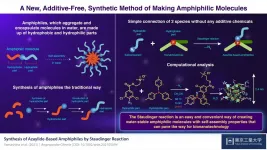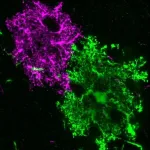Just mix it up: New synthetic method for making amphiphilic molecules without additives
-
2021-06-25
(Press-News.org) Amphiphilic molecules, which aggregate and encapsulate molecules in water, find use in several fields of chemistry. The simple, additive-free connection of hydrophilic and hydrophobic molecules would be an efficient method for amphiphilic molecule synthesis. However, such connections, or bonds, are often fragile in water. Now, scientists at Tokyo Institute of Technology have developed an easy way to prepare water-stable amphiphiles by simple mixing. Their new catalyst- and reagent-free method will help create further functional materials.
Soaps and detergents are used to clean things like clothes and dishes. But how do they actually work? It turns out that they are made of long molecules containing a "hydrophilic" or water-loving part and a "hydrophobic" or water-hating part. When added to water, these molecules self-assemble to form giant, spherical "supramolecules" called micelles that get the cleaning up done by using the hydrophobic part to trap the grease.
Known as "amphiphiles" to chemists, these molecules have garnered much attention due to their utility in developing supramolecular materials. The synthesis of amphiphiles usually requires several reactions and purifications. In contrast, if hydrophilic and hydrophobic molecules could be simply connected without chemicals, it would be a very powerful synthetic method. In fact, some reactions that do not require any catalysts or reagents are known today. However, they have a fatal flaw: their chemical bonds are unstable in water, the very medium necessary for micelle formation!
Addressing this issue in a recent study published in Angewandte Chemie, scientists at Tokyo Institute of Technology (Tokyo Tech), Japan, led by Dr. Masahiro Yamashina and Prof. Shinji Toyota, have now come up with a solution using a chemical reaction known as the "Staudinger reaction", in which an azide (hydrophilic part) and a phosphine (hydrophobic part) combine to form an "azaylide".
"Although a typical Staudinger reaction proceeds rapidly and quantitatively at room temperature, the formed azaylide readily hydrolyses into a primary amine and phosphine oxide in water. In contrast, a 'non-hydrolysis' version of this reaction was recently found, in which a halogen atom, such as chlorine, added to an azide compound significantly improves the hydrostability of azaylide," explains Yamashina.
Accordingly, the team of scientists prepared a chlorinated azide subcomponent and mixed it with tris(p-tolyl)phosphine (PTol3), triphenylphosphine (PPh3), and tris(p-anisyl)phosphine (PAni3) to obtain the azaylide-based amphiphiles NPTol3, NPPh3, and NPAni3, respectively. They then dissolved the amphiphiles in water to observe their self-assembling behavior and found spontaneous aggregation in each case. Further measurements revealed that the aggregates were in the shape of spheres roughly 2 nm in size.
The team also prepared the corresponding non-chlorinated azaylide-based amphiphiles--nNPTol3, nNPPh3, and nNPAni3--and investigated the water stability of both the chlorinated and non-chlorinated azaylides. The non-chlorinated azaylides quickly disintegrated in water while their chlorinated counterparts remained stable. While the difference was clearly due to the presence of the chlorine atom, the underlying mechanism was unclear. To figure this out, the scientists performed density functional theory calculations that helped them understand the structures of the azaylides.
Finally, when tested with hydrophobic organic dyes like Nile Red and BODIPY, the team saw that the dye molecules became encapsulated by the spherical azaylide aggregates, exhibiting desirable amphiphile behavior. "The azaylide formation presented in our study serves as a viable technique for on-site preparation of water-stable amphiphiles without catalysts and reagent, which can help create more such functional materials in future," comments an excited Yamashina.
The team's discovery will certainly help usher in significant advancements in the development of highly versatile functional materials, even in aqueous media.
INFORMATION:
Related links
The wonderful world of ultra-small containers, Supramolecular
https://youtu.be/oNEx3Edpbic
Supramolecular chemistry: Enveloping molecules with molecules - Press seminar held
https://www.titech.ac.jp/english/news/2020/046134.html
Creating a nanospace like no other
https://www.titech.ac.jp/english/news/2019/045515.html
Biomimetics: Artificial receptor distinguishes between male and female hormones
https://www.titech.ac.jp/english/news/2019/044145.html
About Tokyo Institute of Technology
Tokyo Tech stands at the forefront of research and higher education as the leading university for science and technology in Japan. Tokyo Tech researchers excel in fields ranging from materials science to biology, computer science, and physics. Founded in 1881, Tokyo Tech hosts over 10,000 undergraduate and graduate students per year, who develop into scientific leaders and some of the most sought-after engineers in industry. Embodying the Japanese philosophy of "monotsukuri," meaning "technical ingenuity and innovation," the Tokyo Tech community strives to contribute to society through high-impact research.
https://www.titech.ac.jp/english/
[Attachments] See images for this press release:

ELSE PRESS RELEASES FROM THIS DATE:
2021-06-25
A study from UCLA neurologists challenges the idea that the brain recruits existing neurons to take over for those that are lost from stroke. It shows that in mice, undamaged neurons do not change their function after a stroke to compensate for damaged ones.
A stroke occurs when the blood supply to a certain part of the brain is interrupted, such as by a blood clot. Brain cells in that area become damaged and can no longer function.
A person who is having a stroke may temporarily lose the ability to speak, walk, or move their arms. Few patients recover fully and most are left with some disability, but the majority exhibit some degree of spontaneous recovery during the first few weeks after the stroke.
Doctors and scientists don't fully ...
2021-06-25
A near-perfectly preserved ancient human fossil known as the Harbin cranium sits in the Geoscience Museum in Hebei GEO University. The largest of known Homo skulls, scientists now say this skull represents a newly discovered human species named Homo longi or "Dragon Man." Their findings, appearing in three papers publishing June 25 in the journal The Innovation, suggest that the Homo longi lineage may be our closest relatives--and has the potential to reshape our understanding of human evolution.
"The Harbin fossil is one of the most complete human cranial fossils in the world," says author Qiang Ji, a professor of paleontology of Hebei GEO University. "This fossil preserved many ...
2021-06-25
WASHINGTON--Antacids improved blood sugar control in people with diabetes but had no effect on reducing the risk of diabetes in the general population, according to a new meta-analysis published in the Endocrine Society's Journal of Clinical Endocrinology & Metabolism.
Type 2 diabetes is a global public health concern affecting almost 10 percent of people worldwide. Doctors may prescribe diet and lifestyle changes, diabetes medications, or insulin to help people with diabetes better manage their blood sugar, but recent data points to common over the counter ...
2021-06-25
What The Study Did: This study evaluated changes in hospitalization and death rates related to COVID-19 before and after U.S. states reopened their economies in 2020.
Authors: Pinar Karaca-Mandic, Ph.D., of the Carlson School of Management in Minneapolis, is the corresponding author.
To access the embargoed study: Visit our For The Media website at this link https://media.jamanetwork.com/
(doi:10.1001/jamahealthforum.2021.1262)
Editor's Note: The article includes conflict of interest and funding/support disclosures. Please see the article for additional information, including other authors, author contributions and affiliations, conflict of interest and financial disclosures, and funding and support.
INFORMATION:
Media advisory: The full study ...
2021-06-25
What The Study Did: Researchers examined the association of closures of childcare facilities with the employment status of women and men with children in the United States during the COVID-19 pandemic.
Authors: Yevgeniy Feyman, B.A., of the Boston University School of Public Health, is the corresponding author.
To access the embargoed study: Visit our For The Media website at this link https://media.jamanetwork.com/
(doi:10.1001/jamahealthforum.2021.1297)
Editor's Note: The article includes funding/support disclosures. Please see the article for additional information, including other authors, author ...
2021-06-25
What The Study Did: This analysis describes the use of a multifaceted COVID-19 control plan to reduce spread of SARS-CoV-2 at a large urban university during the second wave of the pandemic.
Authors: Davidson H. Hamer, M.D., of the Boston University School of Public Health, is the corresponding author.
To access the embargoed study: Visit our For The Media website at this link https://media.jamanetwork.com/
(doi:10.1001/jamanetworkopen.2021.16425)
Editor's Note: The article includes conflict of interest and funding/support disclosures. Please see the article for additional information, including other authors, author contributions and affiliations, conflict of interest and financial disclosures, and funding and ...
2021-06-25
What The Study Did: Researchers looked at whether age-related hearing impairment among older adults is associated with poorer and faster decline in physical function and reduced walking endurance.
Authors: Pablo Martinez-Amezcua, M.D., Ph.D., M.H.S., of the Johns Hopkins Bloomberg School of Public Health in Baltimore, is the corresponding author.
To access the embargoed study: Visit our For The Media website at this link https://media.jamanetwork.com/
(doi:10.1001/jamanetworkopen.2021.13742)
Editor's Note: The article includes conflict of interest disclosures. Please see the article for additional information, including other authors, author contributions and affiliations, conflict of interest and financial disclosures, and funding and support.
INFORMATION:
Media ...
2021-06-25
Scientists of Tomsk Polytechnic University jointly with their colleagues have synthetized a unique molecule of verdazyl-nitronyl nitroxide triradical. Only several research teams in the world were able to obtain molecules with similar properties. The molecule is stable. It is able to withstand high temperatures and obtains promising magnetic properties. It is a continuation of scientists' work on the search for promising organic magnetic materials. The research findings are published in the Journal of the American Chemical Society (IF: 14.612, Q1).
Magnetoresistive random-access memory (MRAM) is one of the most promising technologies for storage devices. ...
2021-06-25
CHAPEL HILL, NC - When we think of the brain, we think of neurons. But much of the brain is made of non-neuronal cells called glial cells, which help regulate brain development and function. For the first, time UNC School of Medicine scientist Katie Baldwin, PhD, and colleagues revealed a central role of the glial protein hepaCAM in building the brain and affecting brain function early in life.
The findings, published in Neuron, have implications for better understanding disorders, such as autism, epilepsy, and schizophrenia, and potentially for creating therapeutics for conditions such as the progressive brain disorder megalencephalic ...
2021-06-25
TAMPA, Fla. -- E-cigarettes spark many concerns, especially when it comes to youth vaping. However, emerging evidence suggests that e-cigarettes can be a helpful tool in smoking cessation. Researchers in Moffitt Cancer Center's Tobacco Research and Intervention Program wanted to build upon this evidence by testing whether they could help dual users, people who use both combustible cigarettes and e-cigarettes, quit smoking. In a new article published in The Lancet Public Health, they report results from a first-of-its kind nationwide study evaluating a targeted intervention aimed at transforming dual users' e-cigarettes from a product that might ...
LAST 30 PRESS RELEASES:
[Press-News.org] Just mix it up: New synthetic method for making amphiphilic molecules without additives
-

